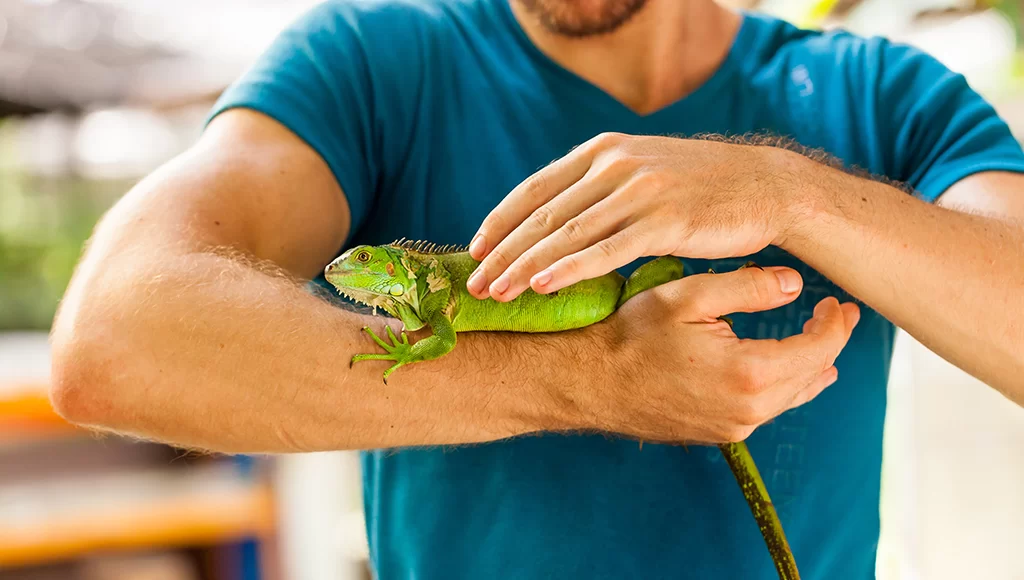How to Keep a Pet Iguana Hydrated: Essential Tips for Iguana Health
- Understanding Iguana Hydration Needs
- How to Provide Water for Your Iguana
- Hydration Problems in Iguanas
- Natural Habitat Considerations for Hydration
- Real-Life Iguana Hydration Experiences
- Recommended Products for Iguana Hydration
1. Understanding Iguana Hydration Needs
Maintaining proper hydration is one of the most important aspects of pet iguana care. Iguanas, particularly green iguanas, require high humidity levels and a consistent water supply to stay healthy. Unlike many reptiles, iguanas are not naturally inclined to drink from a bowl, so understanding their hydration needs is key to preventing dehydration.
In the wild, iguanas often hydrate through rainwater or by licking moisture from leaves. As a pet owner, it is your responsibility to replicate these natural behaviors to ensure your iguana is hydrated. Dehydration can lead to serious health issues, including kidney problems, digestive issues, and shedding difficulties, so proper hydration should be prioritized in your iguana's care routine.
2. How to Provide Water for Your Iguana
Providing the right type of water and in the right manner is essential to ensure your iguana stays hydrated. Here are a few tips to help:
- Water Bowls: While iguanas may not naturally drink from bowls, it’s still important to provide fresh water in a shallow dish. Ensure the bowl is easily accessible and large enough for your iguana to drink from, but shallow enough to prevent any drowning risks.
- Mist the Habitat: Iguanas need high humidity levels to thrive. Mist your iguana’s habitat daily with clean, dechlorinated water. This will help provide moisture for your iguana to drink directly from surfaces, such as leaves and branches.
- Waterfall or Drip System: Some pet owners opt to install a small water fountain or drip system inside the enclosure. These systems can provide running water, which mimics the natural rainwater sources iguanas would encounter in the wild.
- Bathing: Regularly soaking your iguana in shallow, lukewarm water allows it to hydrate by absorbing water through its skin. A 10-15 minute soak a few times a week is beneficial, especially for younger iguanas or those experiencing shedding issues.
By ensuring there are multiple water sources, your iguana will have more opportunities to stay hydrated and maintain proper humidity levels in its environment.
3. Hydration Problems in Iguanas
Dehydration in iguanas can be difficult to detect early on but is often associated with several key symptoms. Knowing what to look for can help prevent serious health problems:
- Dry or Cracked Skin: One of the first signs of dehydration in iguanas is dry, flaky, or cracked skin. If your iguana's skin is becoming brittle, it may be a sign that it is not getting enough moisture.
- Lethargy: If your iguana seems more sluggish than usual or reluctant to move, dehydration could be the cause. Dehydrated iguanas may also show less interest in food or their environment.
- Sunken Eyes: Another indicator of dehydration is sunken eyes. If you notice this, it’s crucial to rehydrate your iguana immediately.
If you notice any of these symptoms, it is essential to address hydration issues promptly. In severe cases, dehydration can cause long-term damage to organs and the immune system.
4. Natural Habitat Considerations for Hydration
In their native habitats, iguanas are exposed to high levels of humidity and access to water sources like rivers and rain. To mimic their natural environment, ensure that your iguana’s enclosure provides the right humidity levels, temperature, and water sources. Here are some environmental factors to consider:
- Humidity: The ideal humidity level for an iguana’s enclosure should range between 60-80%. Using a hygrometer to monitor and adjust the humidity is crucial. A humidity box with moist towels or sphagnum moss can be an excellent addition to the habitat.
- Temperature: Iguanas are cold-blooded animals, and proper temperature regulation is essential for hydration. The basking area should be around 90-95°F, while the cooler side should be around 75°F. A heat source such as a basking lamp will help regulate the temperature.
By recreating the natural conditions of your iguana’s native environment, you can help ensure they remain hydrated and healthy.
5. Real-Life Iguana Hydration Experiences
Many iguana owners have shared their experiences and strategies for keeping their pets hydrated. For instance, Greg, a pet iguana owner from California, had the following to share:
"I struggled with keeping my iguana hydrated at first, as he wasn’t drinking from the water bowl. I started misting his enclosure more often and adding a small fountain, and it made a huge difference. He now drinks regularly and has more energy."
Greg’s story demonstrates the importance of providing various water sources and mimicking natural conditions for hydration. His experience reflects the common challenges many iguana owners face and the effective solutions they find.
6. Recommended Products for Iguana Hydration
If you're looking to improve your iguana’s hydration, consider these products to help maintain proper water levels and humidity:
- Zoo Med ReptiFogger – A humidity control system that helps maintain the ideal moisture levels in your iguana’s enclosure.
- Exo Terra Reptile Fountain – A small, affordable water fountain that provides constant running water, encouraging your iguana to drink.
- Fluker’s Repta Soak – A great soaking solution for providing a bath to help your iguana hydrate and shed properly.
These products are designed to make it easier to keep your iguana hydrated and promote a healthy, thriving environment.
Ensuring that your pet iguana stays hydrated is crucial for its health and well-being. By following these tips and providing the right environment and products, you can support your iguana’s hydration needs. Learn more about iguana care and hydration solutions at Hidden Brook Veterinary.










